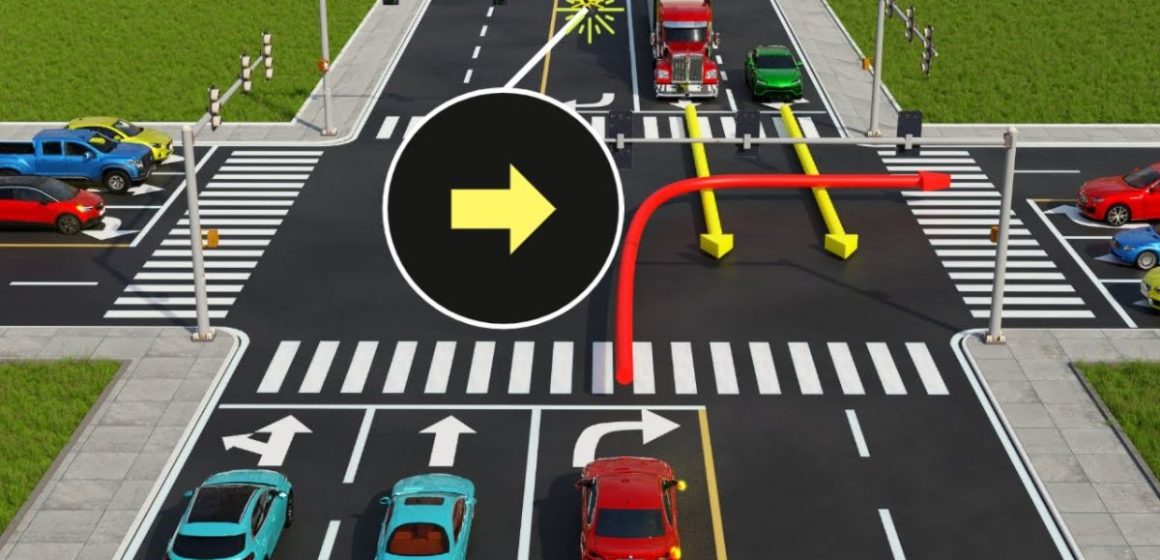Navigating traffic lights can be tricky, especially when it comes to right turns on red. While it seems like a time-saving maneuver, there are important safety considerations and legal implications to understand. This blog post dives deep into the Arkansas Right Turn on Red Rule (RTRR), providing clear explanations, safety tips, and potential consequences of not following the rules.
Whether you’re a seasoned driver in Little Rock or a new resident in Fayetteville, this information will ensure you navigate intersections in Arkansas confidently and safely.
Understanding the Right Turn on Red Rule in Arkansas
- Legality: In Arkansas, right turns on red lights are generally permitted by law under Arkansas Code Section 27-52-107. This means you can turn right after coming to a complete stop at the red light, provided there are no signs prohibiting it.
- Conditions for a Safe Right Turn on Red:
- Complete Stop: This is paramount. You must come to a complete stop before the marked stop line, crosswalk, or intersection line, whichever is closest to the red light. Rolling through the red light is illegal and dangerous.
- Yielding the Right of Way: Even after a complete stop, you cannot turn right on red if oncoming traffic or pedestrians are present in the intersection. You must yield the right of way to all vehicles and pedestrians crossing the street you intend to turn onto.
- Clear Path: Ensure a clear path exists before proceeding with the turn. Oncoming traffic must be far enough away to allow for a safe turn, and pedestrians must have completed their crossing.
- Prohibited Right Turns on Red:
- Signs: Look out for specific traffic signs that prohibit right turns on red. These signs are usually rectangular with red lettering and often display a red arrow or hand with a slash through it. Always obey these signs, even if you see other drivers making the turn.
- School Zones: During school zone hours, right turns on red might be prohibited, even without specific signage. Be extra cautious in these areas and follow all posted speed limits and traffic signals.
- Hazardous Intersections: Certain intersections with high traffic volume, poor visibility, or complex lane configurations might have designated “No Turn on Red” restrictions.
Safety Tips for Right Turns on Red in Arkansas
- Double Check Before You Turn: Don’t rely solely on the car in front of you. Take a moment to scan the intersection for oncoming traffic and pedestrians before initiating the turn.
- Maintain Situational Awareness: Avoid distractions like phones or loud music while approaching and navigating intersections. Be alert and anticipate the actions of other drivers and pedestrians.
- Turn Signal Usage: Always use your right turn signal well in advance to indicate your intention to turn. This helps other drivers anticipate your maneuver.
- Low-Speed Turns: Make the right turn slowly and cautiously, allowing ample time to react to any unforeseen situations.
- Nighttime Visibility: During nighttime or low-visibility conditions, exercise even greater caution. Use your headlights properly and be extra vigilant for pedestrians and cyclists.
Consequences of Violating the Right Turn on Red Rule
- Traffic Ticket: Disobeying the Right Turn on Red Rule can result in a traffic citation. Fines associated with these tickets can vary depending on the county and specific circumstances, but typically range from $50 to $200.
- Points on License: A traffic citation for violating the RTRR might lead to points being added to your driver’s license. Accumulating points can lead to increased insurance premiums, license suspension, or even revocation in extreme cases.
- Accidents: The most significant consequence of a wrong turn on red is the potential for an accident. Running a red light can lead to collisions with oncoming vehicles or pedestrians, resulting in injuries, property damage, and even fatalities.
Right Turn on Red in Different Arkansas Cities
While the general RTRR applies throughout Arkansas, it’s important to be aware of potential variations in specific city ordinances. Here are some examples:
- Little Rock: The capital city generally follows the state’s RTRR guidelines. However, be mindful of designated “No Turn on Red” zones around school zones and high-traffic intersections.
- Fayetteville: Similar to Little Rock, Fayetteville follows the state RTRR. However, the city website provides a downloadable traffic code booklet that drivers can reference for specific regulations at various intersections [link to Fayetteville traffic code downloadable].
Conclusion
Understanding and following the Right Turn on Red Rule in Arkansas is crucial for safe and responsible driving. By making complete stops, yielding the right of way, and exercising caution, you can navigate intersections efficiently while minimizing the risk of accidents. Remember, a few extra seconds spent waiting for a green light can prevent a lifetime of consequences.



Leave a Reply